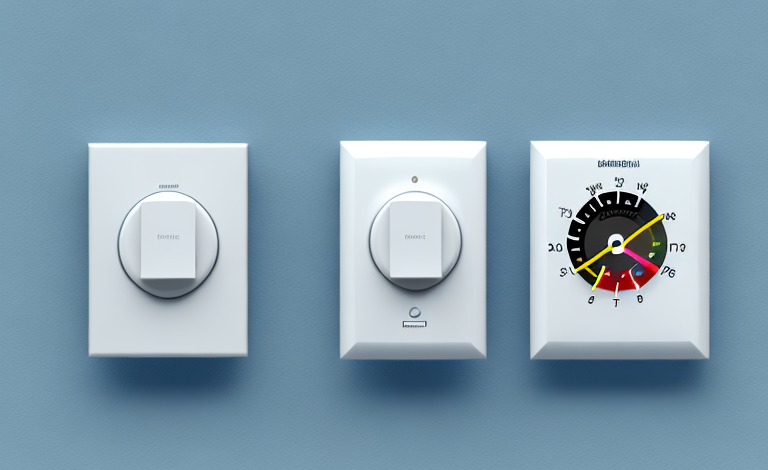If you’re someone who is concerned about saving money on your energy bills, investing in a smart thermostat is a wise choice. While there are several options on the market today, Nest and ecobee have managed to carve out a niche for themselves as two of the most popular choices. But which one is right for you? In this article, we’ll take an in-depth look at both the Nest and ecobee thermostats, and compare them in terms of energy savings, features, cost, user-friendliness, and more.
Introduction to smart thermostats
Before we dive into the specifics of the Nest and ecobee thermostats, let’s first take a look at what smart thermostats are and why they’re worth considering. At their core, smart thermostats are designed to help you save money and energy by automating your home’s heating and cooling. They do this by learning your household’s temperature preferences, adjusting to your routines, and even turning off when you’re away from home.
One of the key benefits of smart thermostats is their ability to connect to your home’s Wi-Fi network, allowing you to control them remotely through a smartphone app or web browser. This means you can adjust the temperature of your home from anywhere, at any time, giving you greater control and flexibility over your heating and cooling system.
Another advantage of smart thermostats is their compatibility with other smart home devices, such as Amazon Alexa or Google Home. This allows you to control your thermostat using voice commands, making it even more convenient and hands-free. Additionally, some smart thermostats can integrate with other smart home systems, such as lighting or security, to create a fully automated and energy-efficient home.
Understanding the differences between Nest and ecobee
While both Nest and ecobee thermostats are designed to save you energy and money, there are some key differences between them. For one, Nest is owned by Google and has a more streamlined design, while ecobee is an independent, Canadian-based company that focuses on customization and flexibility. In terms of features, both thermostats offer many of the same basic functions, but ecobee tends to have more advanced options, such as room-specific temperature sensors and support for multiple zones.
Another important difference between Nest and ecobee is their compatibility with different smart home systems. While Nest works seamlessly with Google Assistant and other Google products, ecobee is compatible with a wider range of systems, including Amazon Alexa, Apple HomeKit, and Samsung SmartThings. This means that if you already have a smart home system in place, you may want to consider which thermostat will integrate more easily with your existing setup.
Features of Nest thermostats
Nest thermostats come in three different models – Nest Learning Thermostat, Nest Thermostat E, and Nest Thermostat 2020. All three models offer the basics, such as auto-scheduling, remote control, and energy history reports. The Nest Learning Thermostat goes a step further by automatically adjusting to your preferred temperatures based on your habits and using geofencing to detect when you’re away from home. It also integrates with Google Assistant and Amazon Alexa, allowing you to control it with voice commands.
The Nest Thermostat E is a more affordable option that still offers many of the same features as the Nest Learning Thermostat. It has a simpler design and doesn’t have the Farsight feature, which displays information on the thermostat when you’re nearby. However, it still has auto-scheduling and energy history reports, and can be controlled remotely through the Nest app. The Nest Thermostat 2020 is the newest model, with a sleeker design and a touch interface. It also has improved sensors for more accurate temperature readings and faster response times.
Features of ecobee thermostats
Ecobee thermostats come in two main models – ecobee SmartThermostat with voice control and ecobee3 lite. Both models offer room sensors that monitor temperature and occupancy, allowing for more customized heating and cooling. They also have features like follow me, which detects which rooms are being used and prioritizes heating and cooling accordingly. The ecobee SmartThermostat also has built-in Amazon Alexa support, allowing you to control it with voice commands without needing an additional device.
In addition to the features mentioned above, ecobee thermostats also have a feature called Smart Recovery. This feature learns how long it takes for your home to reach the desired temperature and adjusts the heating or cooling schedule accordingly, so your home is always at the right temperature when you need it to be. This can help save energy and reduce your utility bills.
Another feature of ecobee thermostats is their compatibility with smart home systems like Apple HomeKit, Samsung SmartThings, and IFTTT. This allows you to integrate your thermostat with other smart devices in your home, such as smart lights or locks, and create custom automation routines. For example, you could set your thermostat to turn off when you leave the house and turn back on when you return, or have your lights turn on when the thermostat detects that you’re home.
Comparing the energy-saving capabilities of Nest and ecobee
When it comes to energy savings, both Nest and ecobee are designed to make a significant impact on your energy bills. The exact amount of savings, however, depends on several factors, such as your home’s size, insulation, and climate. Overall, studies have found that both thermostats can save homeowners up to 20% on their energy bills.
One key difference between Nest and ecobee is their approach to learning your schedule. Nest uses machine learning algorithms to automatically adjust the temperature based on your habits and preferences. Ecobee, on the other hand, relies on sensors placed throughout your home to detect occupancy and adjust the temperature accordingly. This means that ecobee may be better suited for larger homes with multiple occupants, while Nest may be more effective for individuals or smaller households.
Another factor to consider is the compatibility with other smart home devices. Nest works seamlessly with other Google products, such as Google Home and Google Assistant, allowing for voice control and integration with other smart home devices. Ecobee, on the other hand, is compatible with a wider range of smart home platforms, including Amazon Alexa, Apple HomeKit, and Samsung SmartThings.
Cost analysis – which is more affordable?
In terms of cost, both Nest and ecobee thermostats are relatively similar. The Nest Learning Thermostat tends to be slightly more expensive than the ecobee SmartThermostat, but the Nest Thermostat E and Nest Thermostat 2020 are more affordable options. Keep in mind that while the initial cost may seem high, the long-term energy savings can easily balance out the investment.
It’s important to note that the cost of installation may vary depending on your home’s wiring and HVAC system. Some users have reported that the ecobee SmartThermostat is easier to install, which could save you money on professional installation fees. Additionally, both Nest and ecobee offer rebates and incentives for purchasing and installing their thermostats, so be sure to check for any available discounts before making your purchase.
Another factor to consider when comparing the affordability of these thermostats is their compatibility with other smart home devices. If you already have a smart home system in place, such as Amazon Alexa or Google Home, you may want to choose a thermostat that is compatible with your existing devices. This could save you money on purchasing additional devices or upgrading your current system.
User-friendliness and ease of use comparison
When it comes to user-friendliness and ease of use, both Nest and ecobee are fairly simple to install and set up. The Nest Learning Thermostat has a large, easy-to-use touchscreen, while the ecobee SmartThermostat has a slightly smaller display but is still user-friendly. The ecobee app is also well-designed and easy to navigate. In terms of compatibility, both thermostats work with most HVAC systems and can be controlled remotely via their respective apps.
However, there are some differences in terms of user-friendliness and ease of use between the two thermostats. The Nest Learning Thermostat has a more intuitive interface and is easier to use for those who are not tech-savvy. On the other hand, the ecobee SmartThermostat offers more advanced features and customization options, which may be more appealing to tech enthusiasts. Additionally, the ecobee SmartThermostat has a built-in Alexa voice assistant, which allows for hands-free control and adds an extra layer of convenience.
Expert opinion on the best choice for energy savings
At the end of the day, it’s difficult to say which thermostat is objectively better for energy savings. Both Nest and ecobee are top-of-the-line options that offer unique features and benefits. However, many experts tend to lean towards the ecobee SmartThermostat due to its advanced room sensors and customization options.
Compatibility with smart home systems
Both Nest and ecobee are compatible with most smart home systems, allowing you to integrate them with devices like Amazon Alexa, Google Assistant, and Apple HomeKit. The Nest Learning Thermostat also offers a Works with Nest program that allows it to connect with other Nest products, such as security cameras and smoke detectors.
Customer reviews of both Nest and ecobee thermostats
Looking at customer reviews can be a good way to gauge the satisfaction of real-world users. On average, both Nest and ecobee thermostats have received high ratings and positive feedback. Users appreciate the energy savings and ease of use offered by both products.
Installation process comparison
Both Nest and ecobee thermostats come with clear instructions for installation, and both companies offer tutorial videos on their websites. Overall, the installation process is relatively simple and should take around 30 minutes to an hour. If you’re not comfortable with DIY installation, both companies offer professional installation options for an additional fee.
Maintenance required for both thermostats
For the most part, both Nest and ecobee thermostats require minimal maintenance. They both have built-in sensors that can detect when the filter needs to be changed, and the Nest Learning Thermostat even has a feature that reminds you to schedule regular HVAC maintenance. However, it’s still a good idea to regularly check your thermostat’s performance and replace the filter as needed.
Tips for optimizing energy savings with either thermostat choice
No matter which thermostat you choose, there are several tips you can follow to optimize energy savings. These include setting your thermostat to an energy-saving mode when you’re away from home, using room sensors to prioritize heating and cooling, setting a schedule based on your routine, and regularly checking your thermostat for optimal performance.
Conclusion and final recommendation
Both Nest and ecobee are excellent choices for anyone looking to save money on their energy bills while also enjoying the convenience of a smart thermostat. Ultimately, the best choice for you will depend on your specific needs and preferences. If you value customization and room-specific temperature control, ecobee may be the better option. If you’re looking for a more streamlined design and integration with other Nest products, Nest may be the way to go. Regardless of which option you choose, both Nest and ecobee are sure to offer significant energy savings and a more comfortable home environment.



